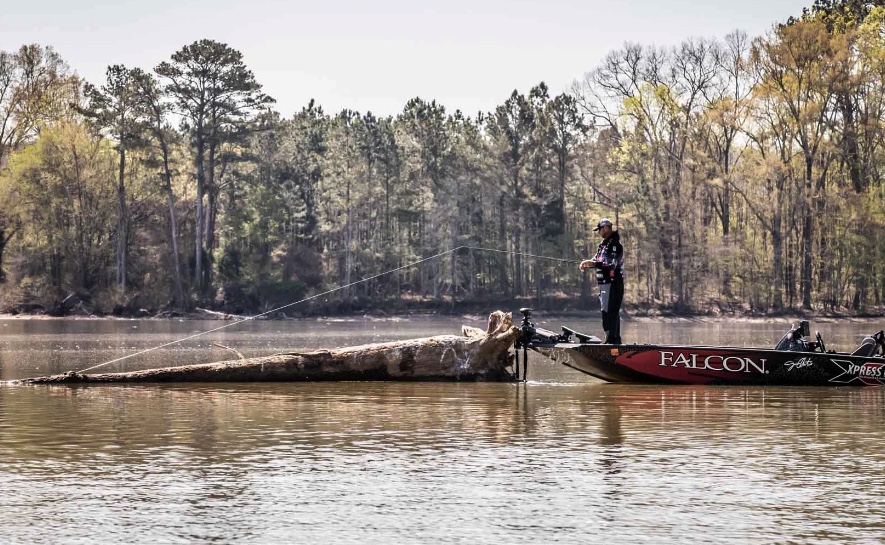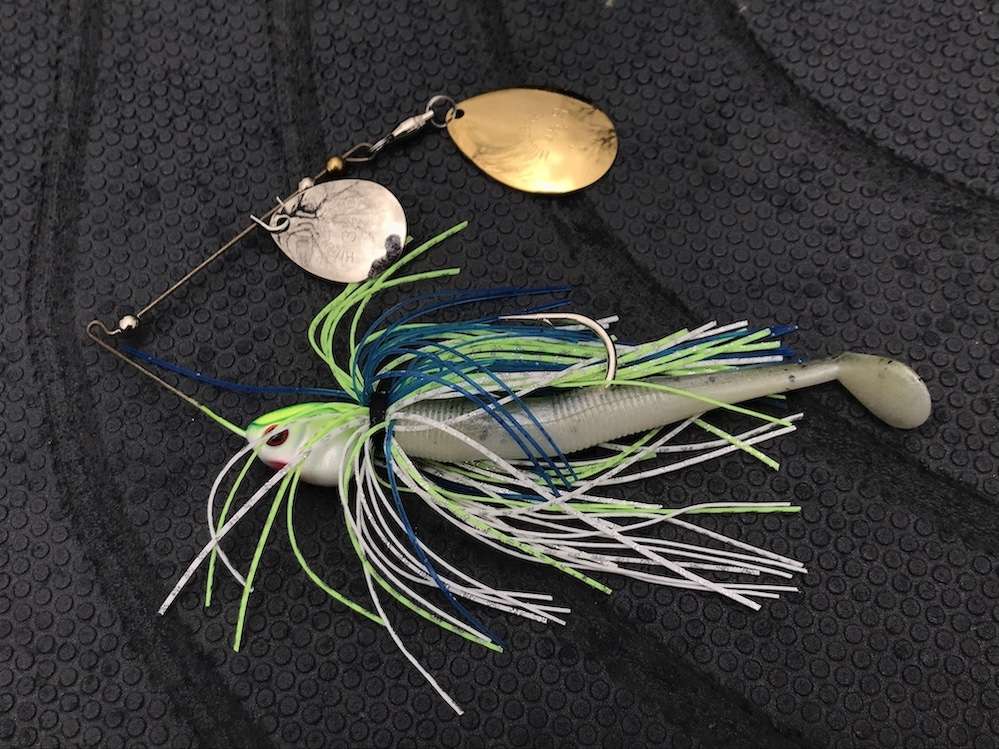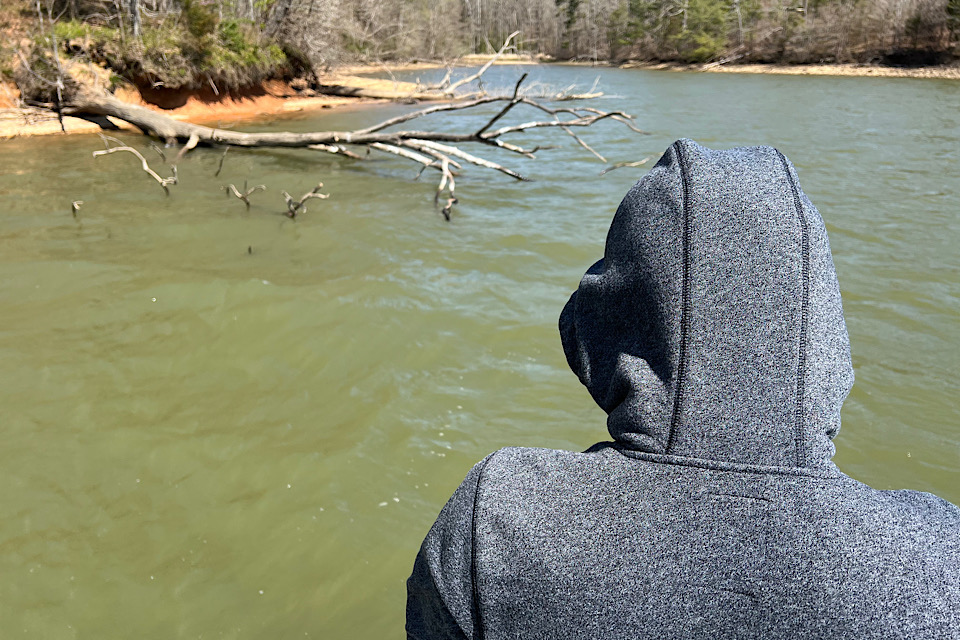
The end of one life helps sustain the survival of many. Perhaps a little dramatic, but that actually does describe how laydowns grant deceased trees a new chapter of usefulness. Shade, shelter, feeding opportunities — this Bass 101 structure serves the food chain by simply existing.
Reigning Bassmaster Classic champion Jason Christie knows his way around a laydown, and he’s definitely had enough time in front of fallen trees to identify replicable patterns. As Christie noted, an exhaustive laydown treatise would take longer than we have. So, let’s hit a handful of key points.
The first point addresses access. “It all depends on the (particular) laydown. Whether it’s big and I have to pick and choose where I can get in there, or if it’s just one of those slick logs.”
Christie said he can cover the latter in one parallel cast with a 1/2-ounce Booyah Covert spinnerbait — what he calls the ultimate weedless reaction bait. The spinnerbait also allows him immediate depth control — reel faster to keep it higher at the shallow end and slower to sink farther on the deeper sections.

In heavily pressured fisheries, Christie might switch to a squarebill, while walking a Heddon Zara Spook over submerged sections often irritates the home run hitters. Notable sections of a slicked off laydown get special attention with a Texas-rigged YUM Christie Critter and a 3/8-ounce weight.
The same baits apply to a fuller tree, with a few more considerations.
Total coverage: “If that tree is big, you almost have to treat it like a bunch of little laydowns,” Christie said. “You go down the main part of the limb, then you move over to another limb and you come down that and try to get some of the trunk. Those are the ones that take a little while to fish effectively.
“Those laydowns with a big canopy and stuff laying everywhere, it may still have leaves on it. That’s where you get into flipping,” Christie said. “Late spring, summer and fall, I love throwing that topwater around big laydowns. You gotta be careful with the treble hooks, but it just seems like you can make the biggest one in there react.”
Mind the angles: A sweet looking laydown with limited access might tempt a commando effort, but Christie warns against overzealous attempts.
“When you can’t get to the laydown, if you make that bad cast, you’re probably going to be hung up,” he said. “That’s why I like baits like a spinnerbait or a swimbait with a belly weighted hook where you don’t get hung up as much.”
Current and laydown fishing
Looking at laydowns in current-exposed areas, where water’s relentless scouring terminally weakens longstanding positions, Christie expects to find most trees with the roots roughly facing the flow and the canopy hanging downcurrent. Here, he comes in from the downstream side and hits the top end first.
“I’m going to make the cast to where I think they’re sitting,” Christie said. “I believe the bigger ones will be in that really thick stuff, or a junction where a big limb comes off.
“It’s the same thing if you don’t have current but you have wind. I want to come in downwind and make my baits come across that laydown naturally.”
Go with (and against) the flow: From the Delaware River, to the Mississippi, Mike Iaconelli’s also keen to take advantage of current-washed laydowns, particularly what he calls flow-throughs. Whenever water passes under a prominent section or between two sections, the accelerated pace spins downcurrent eddies that create feeding lanes where bass can pick off easy meals.
These are definitely high-percentage spots, but Iaconelli stresses the importance of total coverage. “Sometimes, the most aggressive fish will position on the upcurrent side of that laydown, so I always make a couple of flips there, as well.”

The right stuff
Even on the same bank, no two laydowns are identical. Tree size, precise positioning, angle of fall — multiple factors determine laydown position and where each one lays determines how much water covers its various sections.
“You have laydowns that are in a foot of water — the whole thing — and it’s hard to know where they’re going to be if there’s no current,” Christie said. “Then you have the laydowns where the trunk is up there by the bank and the top of the tree is in 5 to 8 feet, and that’s where you have to consider the time of year for fish positioning.
“The fish like those because they can literally move up and down that laydown with fronts, weather and water color. Say you have wind and waves are crashing the bank, and it’s muddy by the trunk. They can move out to the edges where it’s a little bit clearer, or vice versa.”
All alone: Describing his ideal laydown, Christie said his No. 1 preference is isolation. The fall-winter drawdown inherently takes a lot of trees out of play so those retaining sufficient depth are golden. Beyond this, Christie said he always gravitates to the wallflowers.
“If I pull into a creek and on the right side there are 22 laydowns all in a row and on the left, there’s one by itself, I’m probably going to pull into that one,” Christie said. “Even though I’ll get to fish less, there’s just something about them being isolated.”
Waterline: For springtime fishing, Christie looks for laydowns that touch the bank and offer spawning cover. Summer and fall, he wants ‘em off the bank, closer to the deep stuff and encircled by water.
While it’s tough to define a magical depth that’s productive year-round, Christie said he’s always on the lookout for that best-of-both-worlds scenario.
“The ones that are in the water during low and normal stages, those fish know they don’t have to migrate to a fresh log or migrate to one that’s deeper,” Christie said. “It’s like a dock that stays in the water all the time. Fish call that home.”






